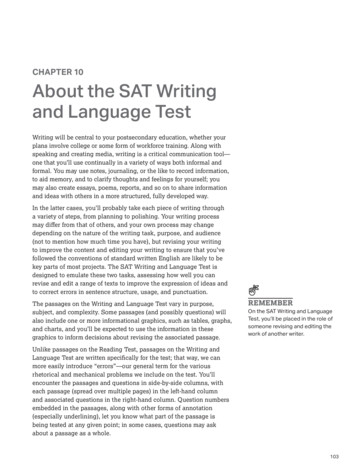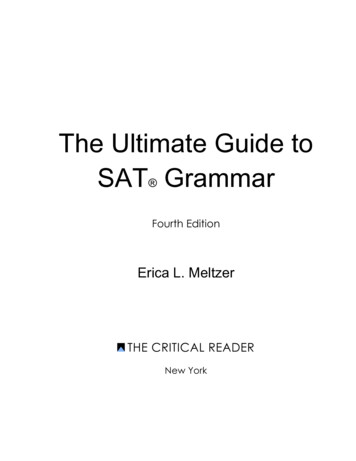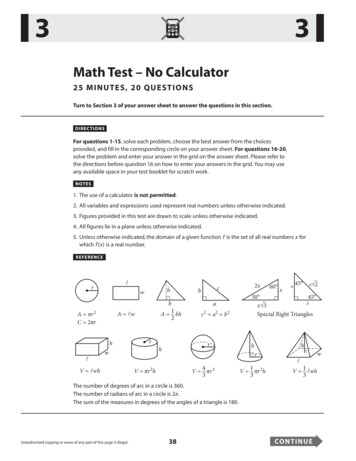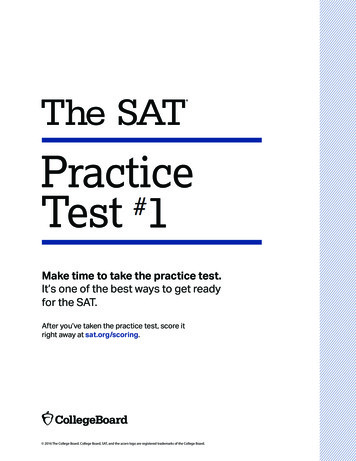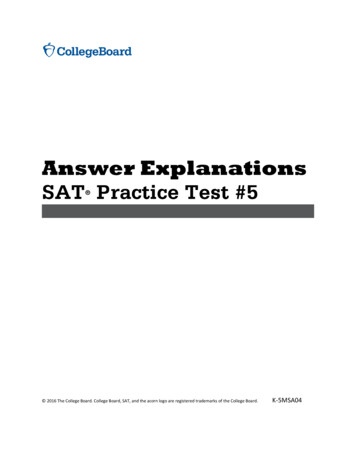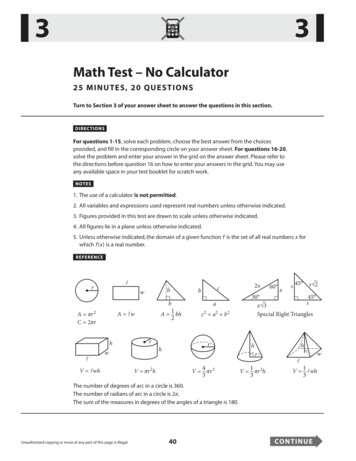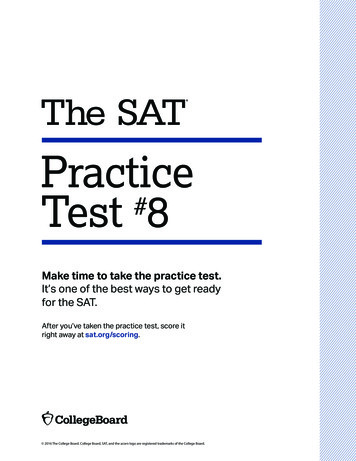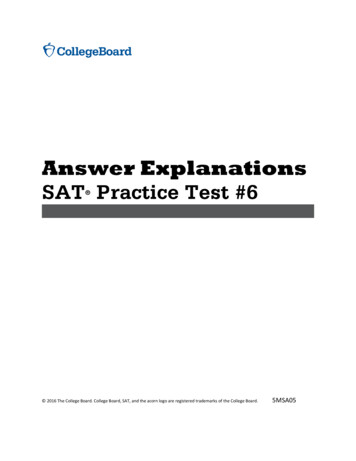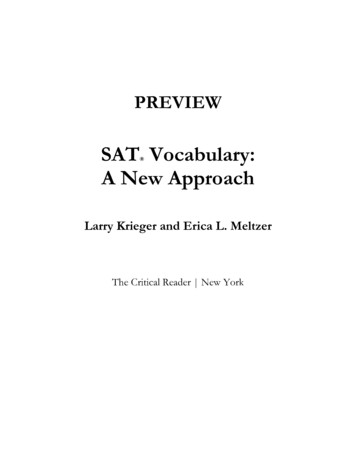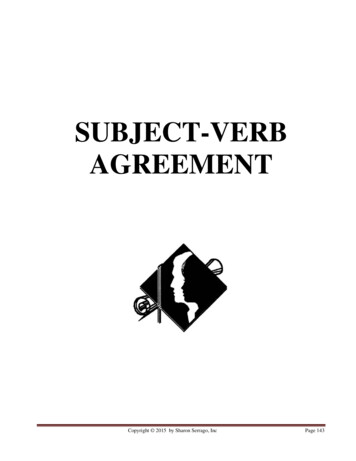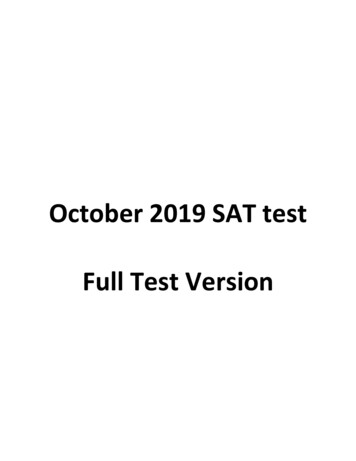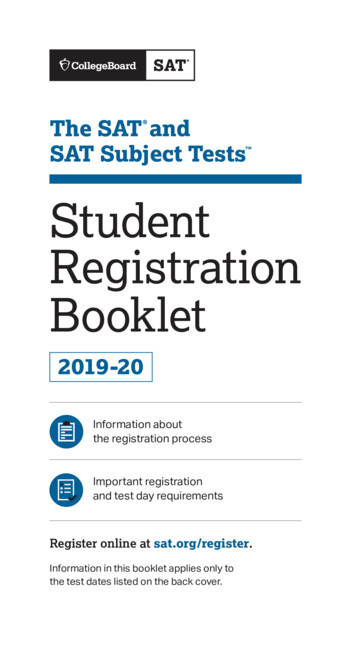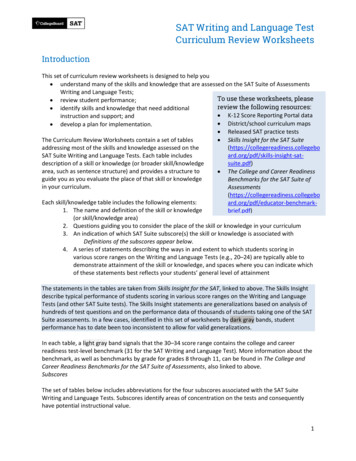
Transcription
SAT Writing and Language TestCurriculum Review WorksheetsIntroductionThis set of curriculum review worksheets is designed to help you understand many of the skills and knowledge that are assessed on the SAT Suite of AssessmentsWriting and Language Tests;To use these worksheets, please review student performance;review the following resources: identify skills and knowledge that need additional K-12 Score Reporting Portal datainstruction and support; and District/school curriculum maps develop a plan for implementation. Released SAT practice testsThe Curriculum Review Worksheets contain a set of tables Skills Insight for the SAT Suite(https://collegereadiness.collegeboaddressing most of the skills and knowledge assessed on theard.org/pdf/skills-insight-satSAT Suite Writing and Language Tests. Each table includessuite.pdf)description of a skill or knowledge (or broader skill/knowledgearea, such as sentence structure) and provides a structure to The College and Career Readinessguide you as you evaluate the place of that skill or knowledgeBenchmarks for the SAT Suite ofin your llegeboEach skill/knowledge table includes the following elements:ard.org/pdf/educator-benchmark1. The name and definition of the skill or knowledgebrief.pdf)(or skill/knowledge area)2. Questions guiding you to consider the place of the skill or knowledge in your curriculum3. An indication of which SAT Suite subscore(s) the skill or knowledge is associated withDefinitions of the subscores appear below.4. A series of statements describing the ways in and extent to which students scoring invarious score ranges on the Writing and Language Tests (e.g., 20–24) are typically able todemonstrate attainment of the skill or knowledge, and spaces where you can indicate whichof these statements best reflects your students’ general level of attainmentThe statements in the tables are taken from Skills Insight for the SAT, linked to above. The Skills Insightdescribe typical performance of students scoring in various score ranges on the Writing and LanguageTests (and other SAT Suite tests). The Skills Insight statements are generalizations based on analysis ofhundreds of test questions and on the performance data of thousands of students taking one of the SATSuite assessments. In a few cases, identified in this set of worksheets by dark gray bands, studentperformance has to date been too inconsistent to allow for valid generalizations.In each table, a light gray band signals that the 30–34 score range contains the college and careerreadiness test-level benchmark (31 for the SAT Writing and Language Test). More information about thebenchmark, as well as benchmarks by grade for grades 8 through 11, can be found in The College andCareer Readiness Benchmarks for the SAT Suite of Assessments, also linked to above.SubscoresThe set of tables below includes abbreviations for the four subscores associated with the SAT SuiteWriting and Language Tests. Subscores identify areas of concentration on the tests and consequentlyhave potential instructional value.1
SAT Writing and Language TestCurriculum Review WorksheetsThe four subscores associated with the Writing and Language Tests are as follows: Command of Evidence (COE): Questions that focus on finding and using textual evidence(e.g., facts, quotations, statistics) in reading and writing (This subscore also includes selectquestions from the SAT Suite Reading Tests.)Words in Context (WIC): Questions that focus on determining the meaning of words andphrases in reading and on rhetorical word choice in reading and writing (This subscore alsoincludes select questions from the SAT Suite Reading Tests.)Expression of Ideas (EOI): Questions that focus on revising text for topic development, logic,cohesion, and rhetorically effective use of languageStandard English Conventions (SEC): Questions that focus on editing text for conformityto the conventions of standard written English sentence structure, usage, and punctuationAll test questions contribute to either the Expression of Ideas or Standard English Conventionssubscores. Select questions also contribute to either the Command of Evidence or Words in Contextsubscore.The College Board decided to focus on these subscores based on the best available evidence aboutessential college and career readiness and success requirements.ProcedureThe following is a step-by-step guide for using this set of worksheets.1. Understand how your students are performing on the SAT Suite Writing and Language Test.a. Review your school and district mean performance on the Writing and Language Testand associated subscores (Command of Evidence, Words in Context, Expression of Ideas,and Standard English Conventions). Record this performance data in the appropriatespaces in the “How Are Students Performing?” table, below.b. Considering the performance data and the subscore definitions above, identify areas ofpotential improvement in the space below the table.2. Familiarize yourself with the Writing and Language Test.a. Review Writing and Language Test directions, passages, informational graphics,questions, and answer explanations from the released SAT practice test to betterunderstand how skills and knowledge are assessed.b. Use the subscore information in this document to better understand how Command ofEvidence, Words in Context, Expression of Ideas, and Standard English Conventions aremeasured on the test.2
SAT Writing and Language TestCurriculum Review Worksheets3. Analyze your curriculum. Using this set of curriculum reviewExplicit is stressed hereworksheets and your curriculum maps, identify for eachbecause instruction oftenskill/knowledge (area) in the tables below (e.g., Development /touches onProposition)skills/knowledge withouta. whether the skill/knowledge is explicitly taught in yourdirectly addressing them,curriculum;making studentb. (if “yes”) in which course(s)/grade level(s) theacquisition less certain.skill/knowledge is explicitly taught;c. in which course(s)/grade level(s) students must demonstrate proficiency in thisskill/knowledge; andd. which of the (generally) four levels of performance described (e.g., at the 20–24 scorerange on the Writing and Language Tests) best represents the highest level at whichyour students generally demonstrate understanding of the skill/knowledge (You mayinstead indicate that your students’ attainment is “below” the lowest level representedor “above” the highest level represented.)4. Develop an action plan.a. Based on the data gathered above, identify three to five skills/knowledge (orskill/knowledge areas, such as Sentence Structure) to devote consistent attention to.b. Use the Skills Insight Suggestions for Improvement as well asother resources to design instructional strategies to fosterUse the Notes space toimprovement.track questions, plansc. Set a time line for implementation of the strategies.for addressing issues,d. List the resources needed for implementation.and next steps.e. Identify means of assessing, formally or informally, whetherteaching and learning have improved in these areas.3
SAT Writing and Language TestCurriculum Review WorksheetsHow Are Students Performing?In the spaces below record the mean scores at the school and district level for the Writing and LanguageTest and for the associated subscores. (Definitions of the subscores can be found in the introductorymaterials for this set of curriculum review worksheets, and the skill/knowledge tables below show howindividual skills/knowledge map onto the subscores.) In the space below the table, identify opportunitiesfor improvement.Writing andLanguageTestCommandof EvidenceWords inContextExpressionof tunities for improvement:4
SAT Writing and Language TestCurriculum Review WorksheetsSAT Writing and Language Test Academic Skills and Knowledge: DevelopmentThis area focuses on topic development in relation to purpose.Development / Proposition: The student will add, revise, or retain central ideas, main claims,counterclaims, topic sentences, and the like to structure text and convey arguments, information, andideas clearly and effectively.Is this skill/knowledge explicitly taught in your curriculum?Scorerange25–2930–3435–40YesNoIf “yes,” in which course(s)/gradelevel(s) is this skill/knowledgeexplicitly taught? When are studentsSubexpected to ents scoring in this range on the SAT Suite Writing and Language Tests aren’t able todemonstrate consistent attainment of this skill/knowledge.COEClarify an aspect of the structure of aEOIparagraph or passage (e.g., using a phrase topreview examples that follow in subsequentsentences)COEEstablish and clarify the structure of aEOIparagraph or passage (e.g., adding a sentenceto frame a paragraph’s discussion or topresent a claim that the paragraphsubsequently supports)COEMake a sophisticated decision relating to theEOIstructure of a paragraph or passage (e.g.,using a clause to set up information when thecontent is complex, the language ischallenging, and the linkage is subtle)Notes5
SAT Writing and Language TestCurriculum Review WorksheetsDevelopment / Support: The student will add, revise, or retain information and ideas (e.g., details, facts,statistics) intended to support claims or points in text.Is this skill/knowledge explicitly taught in your se supporting information to achieve asimple purpose (e.g., providing a short list ofexamples introduced by for instance)Use supporting information to achieve astraightforward purpose (e.g., providing acause for an effect; offering direct evidencefor a claim)Use supporting information to develop a pointor claim logically (e.g., offering a specific,relevant example; using a quotation thatclarifies a concept or observation)Use supporting information to develop a pointor claim logically on the basis of a thoroughunderstanding of a challenging context (e.g.,indicating the last step in a complex sequence;including an example that is similar in contentto one or more other examples in aparagraph)YesNoIf “yes,” in which course(s)/gradelevel(s) is this skill/knowledgeexplicitly taught? When are studentsexpected to demonstrateproficiency?Notes6
SAT Writing and Language TestCurriculum Review WorksheetsDevelopment / Focus: The student will add, revise, retain, or delete information and ideas in text for thesake of relevance to topic and purpose.Is this skill/knowledge explicitly taught in your elete information or ideas that are obviouslyirrelevant to the main focus of a paragraph orpassage (e.g., eliminating a detail that has noapparent relationship to a passage’s topic)Delete information or ideas that are clearlyirrelevant to a paragraph or passage (e.g.,eliminating a detail that interrupts anexplanation or that significantly digresses fromthe main topic)Sharpen the focus of a paragraph or passageby making a thoughtful decision about adding,revising, or deleting information or ideas (e.g.,eliminating material that is broadly relevant toa topic but that is poorly placed or integrated)Sharpen the focus of a paragraph or passageby making a sophisticated decision aboutadding, revising, or deleting information orideas (e.g., adding or retaining optional butrelevant material because it enhancesmeaning and clarity)YesNoIf “yes,” in which course(s)/gradelevel(s) is this skill/knowledgeexplicitly taught? When are studentsexpected to demonstrateproficiency?Notes7
SAT Writing and Language TestCurriculum Review WorksheetsDevelopment / Quantitative Information: The student will relate information presented quantitatively insuch forms as graphs, charts, and tables to information presented in text.Is this skill/knowledge explicitly taught in your esNoIf “yes,” in which course(s)/gradelevel(s) is this skill/knowledgeexplicitly taught? When are studentsSubexpected to ents scoring in this range on the SAT Suite Writing and Language Tests aren’t able todemonstrate consistent attainment of this skill/knowledge.COEUse a general understanding of anEOIinformational graphic, such as a table, graph,or chart, to revise a passage (e.g., drawing onknowledge of what a graph’s bars represent toimprove the accuracy of a passage’sdescription of the graph)COELocate or interpret data in an informationalEOIgraphic, such as a table, graph, or chart, andincorporate them in a passage in an accurate,relevant way (e.g., identifying the value in atable that is associated with a particularcondition; distinguishing between accurateand inaccurate interpretations and betweeninformation relevant and irrelevant to aparticular question or issue)COEInterpret, paraphrase, or summarize data in anEOIinformational graphic, such as a table, graph,or chart, and incorporate them in a passage inan accurate, relevant way (e.g., encompassingmultiple data points in a single relevantgeneral statement)Notes8
SAT Writing and Language TestCurriculum Review WorksheetsSAT Writing and Language Test Academic Skills and Knowledge: OrganizationThis area focuses on logic and cohesion of text at the sentence, paragraph, and whole-text levels.Organization / Logical Sequence: The student will revise text as needed to ensure that information andideas are presented in the most logical order.Is this skill/knowledge explicitly taught in your OI30–34EOI35–40EOISkill/knowledgeOrder the sentences in a paragraph to achievea simple purpose (e.g., grouping relatedinformation together; establishing a basicchronology)Order the sentences in a paragraph to achievea straightforward purpose (e.g., repositioninga supporting detail immediately after asentence that makes a claim)Place or order sentences in a paragraph toaddress a critical issue of logic or cohesion(e.g., adding a sentence to fill a discernible gapin a chronological sequence; repositioning asentence to provide a needed transitionbetween ideas)Place or order sentences in a paragraph toaddress a subtle or complex issue of logic orcohesion (e.g., deciding to reposition ratherthan delete a sentence that, when properlyplaced, improves the flow of ideas in aparagraph)YesNoIf “yes,” in which course(s)/gradelevel(s) is this skill/knowledgeexplicitly taught? When are studentsexpected to demonstrateproficiency?Notes9
SAT Writing and Language TestCurriculum Review WorksheetsOrganization / Introductions and Conclusions: The student will revise text as needed to improve thebeginning or ending of a text or paragraph.Is this skill/knowledge explicitly taught in your ubscore(s)EOIYesNoIf “yes,” in which course(s)/gradelevel(s) is this skill/knowledgeexplicitly taught? When are studentsexpected to demonstrateproficiency?Skill/knowledgeIntroduce a paragraph that has a clear, welldefined focusEOIIntroduce or conclude a paragraph or passagebased on a general understanding of itscontent and purpose (e.g., adding a conclusionthat restates the passage’s main claim)EOIIntroduce or conclude a passage or paragraphbased on an understanding of its content andpurpose (e.g., ensuring that a passage’sconclusion offers an adequate sense ofclosure; achieving a particular rhetorical aim,such as suggesting implications of the findingsdiscussed in the passage)Students scoring in this range on the SAT Suite Writing and Language Tests consistentlydemonstrate attainment of this skill/knowledge in challenging contexts.Notes10
SAT Writing and Language TestCurriculum Review WorksheetsOrganization / Transitions: The student will revise text as needed to ensure that transitional words,phrases, and sentences are used effectively to connection information and ideas.Is this skill/knowledge explicitly taught in your OI30–34EOI35–40EOISkill/knowledgeUse a transitional word or phrase to establisha simple logical relationship betweensentences (e.g., indicating sharp contrast)Use a transitional word or phrase to establisha straightforward logical relationship betweensentences (e.g., indicating a sequence,suggesting a contrast, introducing a definition)Use a transitional word, phrase, clause, orsentence to establish a logical relationshipbetween sentences or paragraphs (e.g.,signaling a shift in emphasis or focus)Use a transitional word, phrase, clause, orsentence to establish a subtle or complexlogical relationship between sentences orparagraphs; recognize when such a device isnot needed or is problematic (e.g., drawing onan understanding of the context to eliminate aword or phrase, such as therefore, thatwrongly suggests a cause-effect relationship)YesNoIf “yes,” in which course(s)/gradelevel(s) is this skill/knowledgeexplicitly taught? When are studentsexpected to demonstrateproficiency?Notes11
SAT Writing and Language TestCurriculum Review WorksheetsSAT Writing and Language Test Academic Skills and Knowledge: Effective Language UseThis area focuses on the use of language to accomplish particular rhetorical purposes.Effective Language Use / Precision: The student will revise text as needed to improve the exactness orcontent appropriateness of word choice.Is this skill/knowledge explicitly taught in your ake an effective word or phrase choice in astraightforward situation (e.g., using acommon but still appropriate expressioninstead of an awkward or meaningless one)Make an effective word or phrase choicebased on vocabulary knowledge and anunderstanding of the context (e.g., recognizingwhen a particular adjective does or does notmeaningfully describe a person or object)Make a nuanced word or phrase choice basedon well-developed vocabulary knowledge andan understanding of the context (e.g.,distinguishing among relatively uncommonwords that have similar denotations butdiffering connotations or uses)Make a sophisticated word or phrase choicebased on highly developed vocabularyknowledge and a thorough understanding of achallenging context (e.g., distinguishing amonguncommon words that have similardenotations but differing connotations or useswhen the distinctions are subtle)YesNoIf “yes,” in which course(s)/gradelevel(s) is this skill/knowledgeexplicitly taught? When are studentsexpected to demonstrateproficiency?Notes12
SAT Writing and Language TestCurriculum Review WorksheetsEffective Language Use / Concision: The student will revise text as needed to improve the economy ofword choice (i.e., to eliminate wordiness and redundancy).Is this skill/knowledge explicitly taught in your liminate obvious wordiness or redundancywithin a portion of a sentence (e.g., removingrepetition within a short phrase)Eliminate wordiness or redundancy within asentence (e.g., recognizing when adjectiveswith the same meaning or very similarmeanings, such as fast and rapid, are used todescribe the same thing)Eliminate relatively subtle wordiness orredundancy within a sentence or betweensentences (e.g., recognizing when informationoverexplains a concept and correctingaccordingly; deleting repetition involving fairlysophisticated language)Eliminate subtle wordiness or redundancywithin a sentence or between sentences andparagraphs (e.g., recognizing that a seeminglysophisticated but wordy expression is lesseffective than a simpler and more economicalone; eliminating the second appearance of thesame detail in successive paragraphs)YesNoIf “yes,” in which course(s)/gradelevel(s) is this skill/knowledgeexplicitly taught? When are studentsexpected to demonstrateproficiency?Notes13
SAT Writing and Language TestCurriculum Review WorksheetsEffective Language Use / Style and Tone: The student will revise text as needed to ensure consistency ofstyle and tone within a text or to improve the match of style and tone to purpose.Is this skill/knowledge explicitly taught in your esNoIf “yes,” in which course(s)/gradelevel(s) is this skill/knowledgeexplicitly taught? When are studentsSubexpected to ents scoring in this range on the SAT Suite Writing and Language Tests aren’t able todemonstrate consistent attainment of this skill/knowledge.WICMaintain a basic consistency in style and toneEOIwithin a passage (e.g., revising language that isclearly too informal or formal for the context)WICMake a thoughtful decision about style andEOItone in a passage based on an understandingof the context (e.g., revising language that istoo informal or formal in a fairly challengingcontext; achieving a particular rhetorical aim,such as establishing a particular sentencepattern or choosing language that sets acontextually appropriate mood)WICMake a sophisticated decision about style andEOItone in a passage based on a thoroughunderstanding of the context (e.g., achieving asubtle rhetorical aim, such as closely matchinga sentence pattern already established in apassage)Notes14
SAT Writing and Language TestCurriculum Review WorksheetsEffective Language Use / Syntax: The student will use various sentence structures to accomplish rhetoricalpurposes.Is this skill/knowledge explicitly taught in your ombine sentences in a relatively simple way(e.g., making a second sentence into a relativeclause of the first) or to achieve a relativelysimple purpose (e.g., eliminating obviousawkwardness or repetition)Combine sentences in a straightforward way(e.g., making a second sentence into aprepositional phrase of the first) or to achievea straightforward purpose (e.g., establishing alogical arrangement of sentence elements)Combine sentences to accomplish a relativelysubtle purpose (e.g., inserting a conjunction toestablish a logical relationship; blendingelements of two sentences to improve logicand flow)Combine sentences to accomplish a subtle orcomplex purpose (e.g., drawing on anunderstanding of the context to place ablended sentence’s emphasis on its mostimportant idea)YesNoIf “yes,” in which course(s)/gradelevel(s) is this skill/knowledgeexplicitly taught? When are studentsexpected to demonstrateproficiency?Notes15
SAT Writing and Language TestCurriculum Review WorksheetsSAT Writing and Language Test Academic Skills and Knowledge: Sentence StructureThis area focuses on a range of skills and knowledge involving standard written English sentenceformation and shifts in construction within and between sentences.Sentence Structure: The student will correct problems in sentence formation as well as correctinappropriate shifts and make necessary shifts in construction within and between sentences.Is this skill/knowledge area explicitly taught in your EC30–34SECSkill/knowledgeYesNoIf “yes,” in which course(s)/gradelevel(s) is this skill/knowledgeexplicitly taught? When are studentsexpected to demonstrateproficiency?Below the 20–24 levelForm conventional, complete sentences,recognizing and correcting a clear andsubstantial disruption in structure (e.g.,eliminating an obvious comma splice;correcting a lack of parallelism in a simpleseries; replacing a nonstandard relative adverbor pronoun with a standard one [a placewhere rather than a place when])Recognize and correct an obviouslyinappropriate shift in verb tense (e.g., usingpresent tense when the context clearly callsfor past tense)Form conventional, complete sentences,recognizing and correcting a disruption instructure (e.g., eliminating an obvious,rhetorically inappropriate fragment;maintaining parallelism in a simple series ofphrases; establishing a clear relationshipbetween an introductory and main clause)Determine appropriate verb tense or pronounperson and number on the basis of anunderstanding of the context (e.g., recognizingand correcting an inappropriate shift frompast tense to present or past perfect tense;making a needed shift from past to presenttense to signal a change in time frame;correcting an inappropriate shift from thirdperson they to second person you)Form conventional, complete sentences,recognizing and correcting a relatively subtledisruption in structure (e.g., eliminating arhetorically inappropriate fragment created by16
SAT Writing and Language TestCurriculum Review Worksheets35–40SECthe use of a semicolon; maintainingparallelism in a series of phrases; choosing oreliminating a conjunction based on anunderstanding of the syntax of a relativelysophisticated or long sentence; correcting anobvious dangling modifier)Determine appropriate verb tense and moodor pronoun person and number on the basis ofa well-developed understanding of the context(e.g., making a needed shift into conditionalmood to suggest a possible but not certainoutcome)Form conventional, complete sentences,recognizing and correcting a subtle or complexdisruption in structure (e.g., ensuring thecompleteness of a sentence with anuncommon structure, such as a sentencecontaining a subject clause beginning withthat; correcting a minor and easily overlookedviolation of parallelism, such as an extraneousor omitted preposition in a series of phrases)Notes17
SAT Writing and Language TestCurriculum Review WorksheetsSAT Writing and Language Test Academic Skills and Knowledge: Conventions of UsageThis area focuses on a range of skills and knowledge involving the conventions of standard writtenEnglish usage.Conventions of Usage: The student will edit text to ensure conformity to the conventions of standardEnglish usage.Is this skill/knowledge area explicitly taught in your EC30–34SECSkill/knowledgeMaintain subject-verb or pronoun-antecedentagreement in a straightforward situation (e.g.,ensuring agreement between subject and verbwhen the number of the subject is clear andthe subject and verb appear close together inthe sentence)Use conventional expression in astraightforward situation (e.g., recognizing andcorrecting a nonsensical expression; choosinga preposition that establishes a logicalrelationship, such as with or for]; choosingappropriately between common words thatare frequently confused, such as to and too)Recognize and correct an obviously vague orambiguous pronoun (e.g., replacing a pronounwithout a clear antecedent with theappropriate noun)Maintain subject-verb or pronoun-antecedentagreement in a somewhat challengingsituation (e.g., ensuring agreement betweensubject and verb when a short phraseintervenes)Use conventional expression in a somewhatchallenging situation (e.g., choosing thepreposition that appropriately completes aphrasal verb, such as call off rather than callup or call on to indicate cancellation; selectingappropriately between less common wordsthat are frequently confused, such as effectand affect)Recognize and correct a vague or ambiguouspronoun based on an understanding of thecontext (e.g., replacing an ambiguous pronounYesNoIf “yes,” in which course(s)/gradelevel(s) is this skill/knowledgeexplicitly taught? When are studentsexpected to demonstrateproficiency?18
SAT Writing and Language TestCurriculum Review Worksheets35–40SECwith a noun after a close reading to determinewhat the appropriate noun should be)Make careful distinctions among thepossessive determiners its and their, thecontractions it’s and they’re, and the adverbthereMaintain subject-verb or pronoun-antecedentagreement in a challenging situation (e.g.,ensuring agreement between subject and verbwhen a clause or multiple short phrasesintervene and possibly suggest a differentnumber for the verb than the subjectwarrants)Use conventional expression in a challengingsituation (e.g., selecting appropriatelybetween relatively uncommon words that arefrequently confused, such as discrete anddiscreet)Maintain subject-verb or pronoun-antecedentagreement in a highly challenging situation(e.g., ensuring agreement between subjectand verb when the two are widely separatedand when intervening text suggests a differentnumber for the verb than the subjectwarrants)Draw logical comparisons using like terms(e.g., The cost of living in the city differs fromthat in the suburbs instead of The cost of livingin the city differs from the suburbs)Use conventional expression in a highlychallenging situation (e.g., selectingappropriately between uncommon words thatare frequently confused, such as defuse anddiffuse)Notes19
SAT Writing and Language TestCurriculum Review WorksheetsSAT Writing and Language Test Academic Skills and Knowledge: Conventions of PunctuationThis area focuses on a range of skills and knowledge involving the conventions of standard writtenEnglish punctuation.Conventions of Punctuation: The student will edit texts to conform to the conventions of standard writtenEnglish punctuation.Is this skill/knowledge area explicitly taught in your EC30–34SECSkill/knowledgeDistinguish between singular and pluralpossessive nouns and between plural andpossessive nounsAppropriately punctuate items in a series (e.g.,a three-item series of nouns withaccompanying adjectives)Use commas to set off a simple nonrestrictiveelement (e.g., a phrase describing the personjust named)Eliminate obviously unnecessary anddisruptive punctuation (e.g., between a verband its direct object)Distinguish among singular, singularpossessive, plural, and plural possessive nounsUse punctuation to set off a nonrestrictiveelement (e.g., an interrupting phrase);eliminate punctuation in
SAT Writing and Language Test Curriculum Review Worksheets 5 SAT Writing and Language Test Academic Skills and Knowledge: Development This area focuses on topic development in relation to purpose. Development / Proposition: The student will add, revise, or retain central ideas, main claims, counterclaims, top
